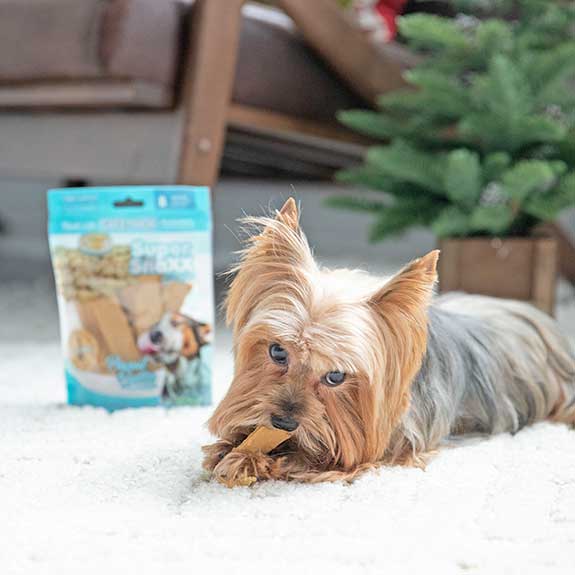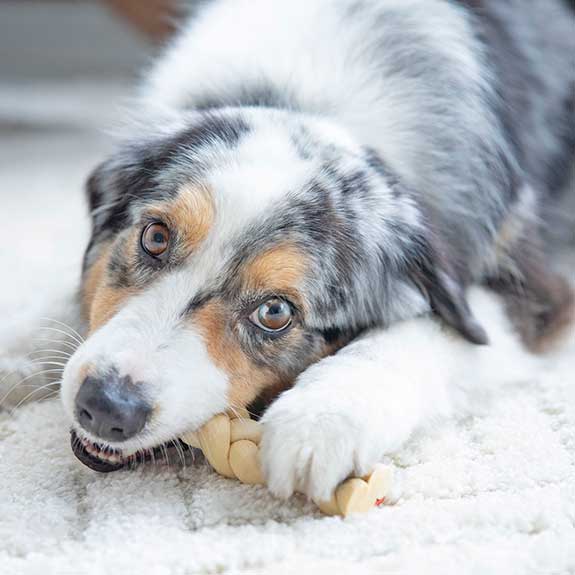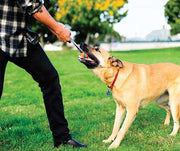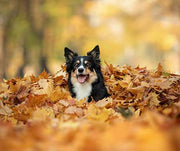Types of Dog Treats

When it comes to choosing a treat for your dog, there are so many options available that it can be hard to know what to look for and what you think your dog will like. If you've been struggling to find a treat that works best with your dog, we've taken a deep dive into the ins and outs of some of the most popular treats.
BENEFITS OF DOG TREATS
There are several ways in which dog treats can be useful and beneficial to your pet. For starters, some dog treats have nutritional benefits that are good for your dog. These can be especially helpful if your pup is a picky eater and is having trouble getting all of the nutrients they need from their regular food. Plus, many treats are even good for your dog's dental hygiene.
Another benefit of dog treats is that they can be used for training your puppy and teaching him tricks. Giving your pup a treat as a reward after they obey a command or perform a trick is a great way to promote positive reinforcement and give them praise.
Last of all, dog treats can be a great way to keep your dog preoccupied if you're trying to get something done and need them to stay busy. Treats can also be helpful if they're anxious about something and need a good distraction.
Just be sure to remember that treats are only good for your pup when they're given in moderation. Treats should never be a replacement for your dog's regular food or meals.
TYPES OF DOG TREATS
As we've mentioned, dog treats come in a wide variety of options. Below are a few choices you'll find, as well as some pros and cons for each.
CRUNCHY TREATS
These are "standard" dog treats and probably what you first think of when you're considering treat options. A few examples are biscuits, bars, cookies, or kibble-style treats. One great thing about these is that you can easily break them into smaller pieces to feed to your dog if you need to exercise portion control. You'll want to be sure that you check the ingredients of any crunchy treats you purchase for your pup. Steer clear of artificial colors, flavors, wheat, or corn as these ingredients can upset your dog's digestive system.
- Pros: Classic option and easy to find in stores. Easy to feed to your dog and little to no mess afterward.
- Cons: Can contain ingredients that aren't the healthiest for your dog. Might not be a good option for dogs with fragile teeth/aging dogs.
CHEWY/SOFT TREATS
Chewy dog treats, such as these snack strips, have more moisture, making them less crunchy and softer to chew on. Like crunchy treats, they are great for on-the-go snacks and can easily be broken into small, bite-sized pieces. Be sure you choose chewy treats that are high in protein and low in fat so that your dog can get the most nutrients out of what they're eating.

- Pros: Easy to feed to your dog and a better option for puppies and older dogs. The smell of these treats makes it more appetizing to dogs.
- Cons: Stronger smell may be unpleasant to humans.
BRAIDS
If you're not familiar with this type of dog treat, braids are a type of chewy treat often made with different flavors. they are then braided together so that your dog can get a savory combination of flavors. A few examples are peanut butter and apple, or chicken and liver, and beef. They take longer for your dog to eat, meaning your dog can stay busy for hours. Some braided treats may even naturally clean your dog's teeth. Be sure to select a braid that's larger than your dog's mouth to prevent choking.

- Pros: Not mess and great for keeping your dog preoccupied. Flavor combinations keeps dogs excited and interested in the treat.
- Cons: Possible choking hazard if you give your dog a braid that's too small
FREEZE-DRIED/JERKY
Finally, freeze-dried treats are the healthiest option of dog treats available! They are made with only one ingredient – usually meat or a vegetable – that has been dehydrated in order to make the treat dry and long-lasting. These treats usually don't have any other ingredients or additives. Dogs tend to be very attracted to jerky-type treats, which is why they can be a great option to use when training.
- Pros: A healthy treat option and a great training aid. No mess
- Cons: Some may have preservatives that are not the healthiest for your dog.
TREATS YOUR DOG SHOULD AVOID
What are some dog treats that you should avoid feeding your dog? Below are a few:
- Rawhide: Although rawhide may seem like a healthy and more "natural" option for dogs, rawhide has several risks. It is sometimes treated with chemicals that may upset your dog's digestive system. It can also be high in fat and calories, making it a poor choice for dogs who are already overweight. In addition to this, it can contain harmful bacteria that may lead to severe illness, and on top of this, rawhide also has a high choking hazard risk.
- Animal Bones/Hooves: Bones and hooves should also be avoided. They can cause your dog's teeth to chip or break as well as cause gastrointestinal issues or blockage. Plus, they can splinter and poke your pet's insides, which can lead to serious problems. No matter if it's raw or cooked, you should always steer clear of feeding your dog animal bones or hooves.
CONCLUSION
With so many treat options available, it can be difficult to know what kind will work best for your dog. Hopefully this has been a helpful guide as you take into account your dog's age, size, chewing temperament, and health history. Be sure to consult your vet for any specific questions.
Previous article

Next article

Related posts
View all-

Celebrate National Pet Week: Fun Ideas to Celebrate with Your Pet
National Pet Week is right around the corner, so it's time to plan how you're going to celebrate! While we're sure you celebrate your pet all day every day... Read Article -

5 Simple Tips to Make Sure Your Cat Drinks Enough Water
Ensuring your cat stays hydrated is important, but it can be challenging since many cats don't drink enough water. Dehydration can lead to kidney disease and other health issues. Fortunately, you can encourage your cat to drink more with a few simple changes. Read Article -

How to Keep Your Cat Busy at Night (So You Can Sleep)
For many cat owners, the quest for a good night's sleep while keeping their feline friends content and engaged can seem like a never-ending battle. Cats, naturally more active at night or early in the morning, often disrupt your sleep schedules with nocturnal activity, whether through playful nature or seeking attention. Read Article



